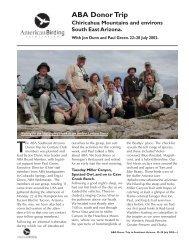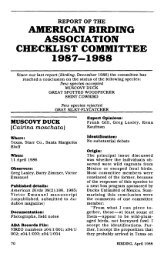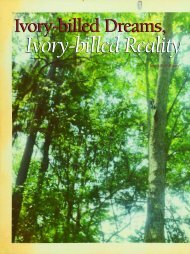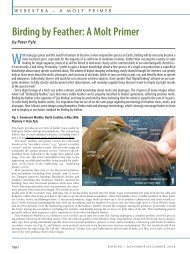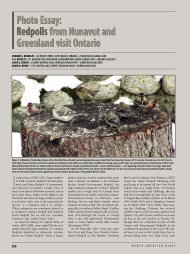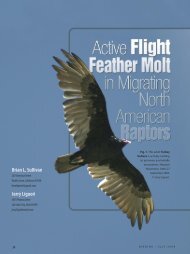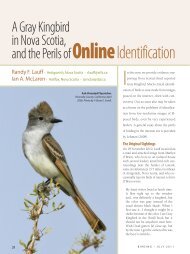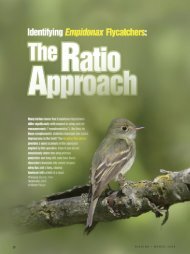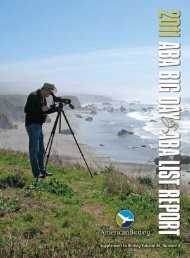Front End - American Birding Association
Front End - American Birding Association
Front End - American Birding Association
Create successful ePaper yourself
Turn your PDF publications into a flip-book with our unique Google optimized e-Paper software.
with a guard rail. I have now consumed an entire box of Good & Plenty candies and am<br />
going to be sick on the computer, so this is necessarily my conclusion. We believe 150-<br />
160 is a reasonable goal for early June.<br />
P.S.: I did not actually see a Fork-tailed Flycatcher in Northampton County, Pennsylvania.<br />
If you contact me to ask about this, we can no longer be friends.<br />
TENNESSEE – 2 Jun 08- 0430 to 2120 – Species Totals 121/121; (Team/Shared): Rick<br />
Knight 121. 248 Miles by car, 4 miles by foot. Visiting: Three counties in the northeastern<br />
portion of the state, with key stops at Buffalo Mountain, Austin Springs, Winged<br />
Deer Park, western Washington County, Elizabethton, Wilbur Lake, Roan Mountain.<br />
Species of note: Blue-winged Teal (L), Northern Shoveler (L,S), Great Egret (L),Worm-eating<br />
Warbler (M).<br />
Comments: This is a new June Big Day record for Tennessee.<br />
TEXAS – 19 Apr 08- 0000 to 2400 – Species Totals 260/260; (Team/Shared): Ken Beherens<br />
260, Cameron Cox 260, Pete Nosner 260, Michael Retter 260. 856 Miles by car,<br />
2 miles by foot. Visiting: Hidalgo, Uvalde, Frio, McMullen, Live Oak, Nueces,Aransas and<br />
Calhoun counties. Species of note: Least Bittern (M),Wood Duck (R), Greater Yellowlegs<br />
(M), Green Kingfisher (M), Clay-colored Thrush (R,S), Scarlet Tanager (M), Lazuli Bunting<br />
(R), Pine Siskin (R,L).<br />
The quest that ended in Port Aransas had begun a long time before. Each member of<br />
the team had a long history of birding Texas, and was a longtime veteran of the Texas<br />
<strong>Birding</strong> Classic.While the Classic is a fantastic challenge, the strategy when pursuing as<br />
many birds as possible over five days is quite different from any single Big Day route.<br />
The Classic is also restricted to the coast, and doesn’t include the Hill Country of central<br />
Texas - an area essential to any attempt at an ABA area Big Day. While racking up<br />
totals well over 200 species on single days of the Classic, we couldn’t help but think of<br />
how many we might get on a true “Big Day”.<br />
In April 2007, a team that included Cameron, Pete, France Dewaghe, and I converted<br />
our long-ruminated thoughts of assaulting the record into action. The day was fantastic<br />
until we made a late afternoon stop for Horned Lark in Calhoun County. Despite<br />
being parked well off the road, we were sideswiped by a careless driver. Hours on the<br />
phone with the rental company, police, insurance representatives, and a long and expensive<br />
taxi ride followed. Incredibly, we had tallied 251 species before the accident brought<br />
us up short. Breaking the record would have taken tremendous luck, but it was frustrating<br />
for the day to end as it did. All of us wanted another shot.<br />
The team assembled again in 2008, although Michael was swapped for France, who<br />
was unable to escape work.This year, we spent weeks scouting much more extensively,<br />
particularly in the Hill Country. We also decided to add the Lolwer Rio Grande Valley to<br />
our route - starting there at midnight.This addition to our strategy was the main difference<br />
between our route and that of the previous record holding run.<br />
When April 19th rolled around, everything was in place. The investment of countless<br />
hours of strategizing and scouting now rode on the caprice of Texas bird migration. As<br />
the clock hit midnight, we were stationed near the Rio Grande, and quickly heard our<br />
first owls and Paraques. Even though night migration has little bearing on how many<br />
birds are on the ground the next day, we were encouraged to hear the sky full of the<br />
calls of migrating Dickcissels.<br />
A quick and highly successful nocturnal run through The Valley left us confident and<br />
elated, but with a long drive ahead of us. Hours into the drive, just when we were all<br />
having difficulty staying awake, a deer decided to liven up our morning by throwing itself<br />
in front of our vehicle. For a few moments, we feared a recapitulation of the previous<br />
year‘s frustrating end to the Big Day, but a quick examination of the car revealed<br />
only a smashed headlight and a slightly crumpled fender. The loss of a headlamp was<br />
far from debilitating, so we continued into the night. Although our lonely headlight attracted<br />
the interest of local police, the car was fine; we had made a very lucky escape<br />
from a potentially Big Day-ending disaster.The adrenaline rush of the collision did more<br />
than gallons of Red Bull to ensure that the team was alert at sunrise.<br />
Dawn found us in the wonderland of the Hill Country. Although it is always frustrating<br />
to speed through such an area on a Big Day, I had been able to thoroughly enjoy it<br />
while scouting.This area holds a bizarre mix of birds unlike anywhere else in the US.Acadian<br />
Flycatchers and Yellow-throated Warblers sing from the lush river bottoms while<br />
Rufous-crowned Sparrows and Canyon Wrens preside over the sparsely vegetated, rocky<br />
heights. In addition to being one of the world’s most remarkable natural playgrounds,<br />
the Hill Country is perfectly suited for a Big Day, offering a huge variety of birds, most<br />
of which are impossible to find elsewhere during the day. Our route ran superbly, and<br />
we were pleased to pick up some bonus species like a late Hermit Thrush and a Lazuli<br />
Bunting that flew into a feeding station just as we were pulling away.<br />
Streaking across the swath of dry sub-tropical brush that separates the Hill Country<br />
from the coast, we scanned the skies until our eyes burned. Although we had to cross<br />
this area quickly, it held birds that we needed. Most of the scrub species fell into place<br />
quickly, but migrant hawks proved more difficult. Eventually we picked a Sharp-shinned<br />
Hawk out of the sky after numerous Cooper’s. Late <strong>American</strong> Kestrels and Northern Harriers<br />
were great to see, as these birds were on the verge of leaving in favor of more<br />
northern climes. Small stock ponds held a good variety of lingering ducks and migrating<br />
shorebirds.<br />
The brush country behind us, we launched into the coastal segment of our day with renewed<br />
vigor. Our first stop was Tule Lake, which is graced with incredible numbers of shorebirds<br />
throughout spring migration. There was probably nowhere else on the route where<br />
we added so many birds in such a short time. A couple of stops for stakeouts were quick<br />
and successful, and our ceaseless scanning paid off when we spotted a single Franklin’s<br />
Gull and a mixed group of Broad-winged Hawks and Mississippi Kites floating overhead.<br />
As we drove into Corpus Christi, the burning question on all of our minds was “will<br />
there be enough migrants?” Blutcher Park was our first migrant spot, and the scene was<br />
initially frightening; there seemed to be no migrant passerines.As we checked more carefully,<br />
though, most of the understory species fell into place - from Swainson’s and Kentucky<br />
Warblers to thrushes. A Clay-colored Thrush that had been in the area for weeks was an<br />
excellent addition to the list.Although the ground-dwellers were much in evidence, more<br />
arboreal birds were almost non-existent.At the end of the day, Black-throated Green was<br />
our only Dendroica, and we didn’t find a single Empidonax flycatcher.We had scraped together<br />
just enough migrants. A solid day of migration could have given us the record by<br />
a wide margin, while we would have fallen short on a worse migration day.<br />
The beaches and roads of Mustang Island were packed due to a sand castle festival,<br />
and the ferry across to Aransas Pass had a long wait. Fortunately, we had foreseen this<br />
potential problem, and left a second car on the other side.We walked on, bypassing the<br />
long vehicle line, and were soon across and squeezing into a significantly smaller car.<br />
On the bright side, this car had two functioning headlights! In Rockport, we completed<br />
our suite of ducks, and even added an unexpected Bufflehead. Other bonus birds were<br />
a lingering Brown Thrasher and LeConte’s Sparrow.<br />
Working our way north, we entered the riverine forests north of Port O’Conner, which<br />
seemed remarkably lush after the arid stretch we’d been in since leaving the Hill Country.<br />
With a little effort, we turned up <strong>American</strong> Crow and Red-bellied Woodpecker in<br />
this habitat.<br />
With a hazy sunset swirling across the western sky, we rocketed towards Calhoun<br />
County, the place that would make or break our Big Day run, and where the previous<br />
year’s attempt had met its doom. Our destination was a cluster of rice fields that we had<br />
scouted for freshwater shorebirds. The first scan seemed to spell disaster; water levels<br />
had dropped drastically, and the previous day’s hordes of Hudsonian Godwits seemed<br />
to have vanished. Slowly, however, we teased new species out of the acres of muddy rice<br />
fields. Least expected was a Wilson’s Snipe that flew overhead calling just as we lost<br />
enough light to search for godwits.<br />
Having averted disaster in Corpus and Calhoun, we knew we were very close to a new<br />
record. Throughout the day, we had been tracking our progress using a laptop. A postdusk<br />
tally found us one bird shy of history. This was probably the high point of the day,<br />
as we were now almost assured of the record. All of our hard work, including long<br />
weeks of scouting, strategizing, and little sleep had paid off.<br />
We tied the record with a gratifyingly vocal Black Rail.A ghostly Barn Owl a short time<br />
later clinched the record. Remarkably, Black Skimmer was still absent from our list. Apparently<br />
all the skimmers had been pushed off the crowded beaches and causeways of<br />
the coast.We knew of a breeding colony near Rockport, and soon after pulling up were<br />
relieved to hear the odd honking call of a skimmer cutting through the sultry humidity<br />
of the coastal night.<br />
Unsuccessful attempts at a couple other birds brought us to the Port Aransas <strong>Birding</strong><br />
Center, where we whiled away the last few moments of our record-setting day. Exhausted<br />
enough that our need for sleep trumped our need for food, we settled into a<br />
hotel for some hard-earned rest.<br />
The ridiculous number of birds that can been seen in a day in Texas clearly illustrates<br />
what a priority the conservation of key areas in that state should be - particularly the<br />
fast-disappearing migrant stopover sites along the Gulf of Mexico.<br />
The EDG Team owes a debt of gratitude to many people. First, and most importantly,<br />
thanks to our sponsors: Nikon Sport Optics and <strong>Birding</strong> America. Thanks also to Wildbird<br />
Magazine. Though not a sponsor this year, they sponsored all of us during many<br />
years of Texas <strong>Birding</strong> Classic competitions. We are also very thankful for the information<br />
provided by the birders we met while scouting. Their advice was critical at several<br />
points during the day.<br />
VERMONT #1 – 29 May 08- 0000 to 2322 – Species Totals 161/159; (Team/Shared):<br />
Allan Strong 161, Dan Strong 161, Peter Jones 159. 464 Miles by car, 6 miles by foot.<br />
Visiting:Winooski River, Brandon,Whiting, Champlain Valley from Addison to Missisquoi<br />
18 | 2008 ABA Big Day Report & ABA List Report



